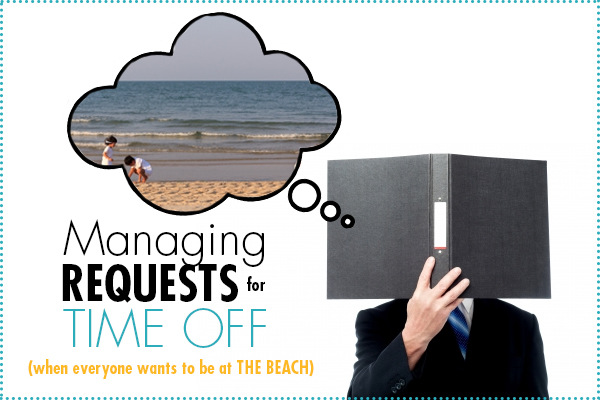It's that time of year: Everyone wants to be on vacation. Keeping things running smoothly while managing time-off requests for in a fair manner could be a challenge for any business owner or manager. Here are a few tips for managing the deluge of requests for days off:
- Have a policy firmly in place. Make sure new employees are made aware of it during orientation, and periodically revisit it with current employees. Your policy may designate the process to request time off; the number of days off an employee can request per year, quarter, month, et cetera; how decisions to grant days off are made: first come, first served or by seniority, and so on. Your policy may also address whether or not the same person could have spring break (or other high-demand time periods) off in consecutive years.
- Make employees aware of time periods you anticipate being the most busy, and make it clear in advance that days off during those periods will be limited. Likewise, you might wish to identify slow time periods, when employees could take time off and not worry that work will pile up in their absence.
- Maintain a calendar visible to all employees, so they can see days off that have already been granted.
- Arrange for cross-training in advance of an employee's absence. If you grant an employee more than a couple of days off, develop a plan with them for how their workload will be managed in their absence, which may include training other employees to manage some of their co-workers' tasks.
Flextime policies during the summer months, such as allowing four ten-hour days with Friday off, or allowing flexibility regarding start and end times, are another way to accommodate employees' desire for time off, without interrupting work flow. Staggering employees' schedules may be necessary for adequate coverage, however, and concern about burnout and lower productivity from working longer hours has caused some employers to get creative with scheduling, like offering employees the opportunity to work eight nine-hour days and one eight-hour day, with every other Friday (or Monday) off.
A range of studies have shown that workers who use their vacation time are more satisfied with their jobs, and more productive. Yet a 2013 study by Right Management found that nearly seventy percent of Americans leave vacation time unused each year. A survey conducted by Hotwire in 2012 found the average annual amount of unused vacation time was twelve days. While part of this reluctance to use vacation time had to do with workers' economic situations, office climate and fear of being viewed as a less dedicated employee were also contributing factors. However, research indicates that employees are less stressed, more productive, and more likely to engage in critical thinking if they use their vacation time. Establishing a climate that encourages employees to use their vacation time, and truly disconnect, can help a business's bottom line, not just its employees.
While finding a way to encourage employees to use their vacation time without creating a hiccup in workflow can be a challenge, a combination of communication and creative planning cound ensure everyone can enjoy some time at the beach, hopefully without their laptop and other office accoutrements.




